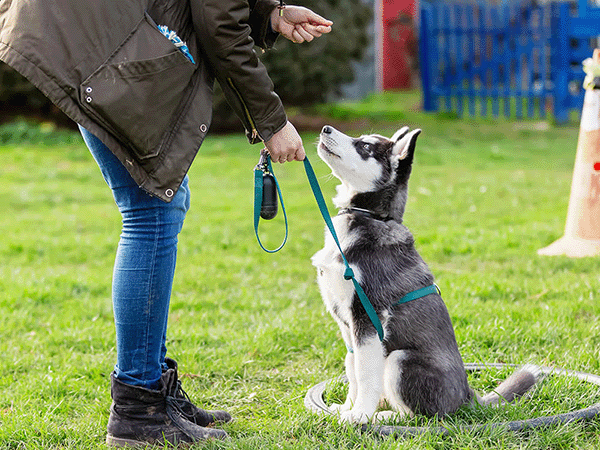Dog Whining: Why It Happens and How to Stop It

* All Sniffspot articles are reviewed by certified trainers for quality, please see bottom of article for details *
If you love a dog, then you’re probably familiar with their range of canine vocalizations: barking, growling, and of course whining. If you’ve ever heard your dog crying and wondered what they’re trying to tell you — or felt overwhelmed because you can’t seem to get them to quiet down — this article is for you.
Let’s break down everything you need to know about your dog’s cries. Is whining normal? What causes your pet to cry? And what can you do about it to reduce the noise?
Why do dogs whine and cry? Is it normal?
First things first: Whining is a normal dog behavior.
Whining is most commonly seen in young canines, but because domestic dogs are neotenized compared to their wolf ancestors (a fancy word to say they retain juvenile traits into adulthood) it’s normal for our pets of all ages to whine on occasion. Adult animals can have a good cry too!
Dog crying versus whining
Dogs don’t regularly shed emotional tears (either happy tears or those from emotional distress) through canine tear ducts like humans do. In fact, if your dog has eye discharge, it's probably cause to consult with your local vet to rule out the possibility of an eye infection or similar problem affecting their natural tear volume.
When we talk about our pups crying, we're primarily referring to their vocalizations. Typical domestic dog whining can take many forms from intense cries to soft whimpers.
While the exact display is different—wet tears of emotion versus sounds of emotion—dogs do cry and whine for a similar variety of reasons as humans do. Our pets can also experience feelings of sadness, frustration, and related emotions.
There are many things your dog might be trying to communicate when they whine!
Dogs might whine in greeting or out of excitement
Many dogs whine when they’re in a state of arousal, especially during high energy greetings — like when you walk through the door after being gone for a full work day. These cries are often accompanied by loose, excited body language like a widely wagging tail. Your dog will probably also make eye contact with you — and if you look right at them back, it can encourage them to keep saying hello until you come all the way over.
You can read more about interpreting your dog’s body language in this article.
Dogs might whine as an appeasement behavior
Some dogs whine as an appeasement signal when they interact with people or other dogs. They’re essentially trying to say that they aren’t a threat — they feel uncomfortable and want to dispel potential conflict before it starts.
Appeasement displays are usually accompanied by a submissive posture, with head down, tail tucked, and ears back.
Dogs might whine for attention
Dogs also whine as an attention-seeking behavior. Many of our pets have learned that humans attend to their cries! Some professionals believe that dogs actually whine more to communicate with people than they do to communicate with other dogs.
Attention or boredom whining might also be correlated with destructive behaviors, like chewing your furniture.
Dogs might whine to express a need or want
Consistent whining can also be a sign that your dog isn't getting enough fulfillment: opportunities to express natural canine instincts and behaviors. Regular exercise, at-home enrichment activities, social interaction, and physical contact with you as their pet owner can help your pup feel satisfied and calm.
Dogs might whine when they’re anxious (especially if left alone)
It’s normal for dogs to whine in response to stressful situations. This type of crying often seems involuntary — your dog isn’t doing it to get your attention (and certainly not to drive you crazy) but rather because it’s a natural response to feeling anxious. Whining is one of the most common nervous behaviors our pets exhibit.
Why do dogs cry in their crates or kennels?
Anxious whining is perhaps most common when dogs struggle with separation distress. If your dog routinely cries when you leave them alone in their crate, the culprit is probably some form of isolation or separation anxiety.
Remember that dogs are social, sensitive animals. They naturally want to be with their family members and friends! It’s normal for them to feel distressed about spending time alone, especially if they’re new to your home or you’ve recently changed your routine — but it’s also important they can handle those situations when they do have to happen.
Some dogs might also cry in their crates because they don’t enjoy the sensation of being confined. Appropriate crate training, where you make sure the kennel is the right size and work to build a positive association, can go a long way.
You can read more about crate training here.
Dogs might whine because they’re in pain
Canines might cry when they’re in pain, not unlike the way we humans whimper or moan when we get hurt. It’s especially important to consider the possibility of physical discomfort if your dog suddenly goes from whining very little to crying often. New vocalizations can be an indicator of illness or injury atop other physical symptoms (which are often hard to notice in stoic dogs).
A common cause of whining due to pain is joint issues, which are common in a range of breeds — especially large dogs — as our pets get older. Our pups can also experience internal discomfort from things as complicated as undiagnosed medical conditions and as temporary as accidentally consuming expired food ingredients.
It’s also important to note that just because a dog isn’t whining doesn’t mean they feel one hundred percent. Canines can be incredibly reserved in displaying discomfort. While crying certainly is one symptom of physical distress, it’s not the only thing to consider.
Common question: Why do dogs sometimes cry in their sleep?
If your dog cries in their sleep, they are probably reacting to a dream. Yes, dogs dream, just like humans do! Their dreams probably involve versions of their daily lives or recreations of that day’s activities. When they are dreaming, their legs may twitch (almost like they’re trying to run), their mouth may move, and they might even start tail wagging (to often adorable effect).
It may be tempting to wake your dog if they start to whimper in their sleep — but as the saying goes, it’s best to let sleeping dogs lie. Waking a dog from a dream will actually disturb their sleep cycle, which can lead to more waking problems down the line. You also run the risk of startling your companion, which can cause them to react to your presence in a way they usually wouldn’t. Unless something appears to be seriously wrong (like the onset of a medical issue such as seizures as opposed to just an intense dream) let your dog sleep even through their sad-sounding noises.
Do certain breeds whine or cry more than others?
There is no research indicating that some breeds specifically cry more than others — but there are dog breeds that have a wider range of vocalization. Some tend to be more “talkative.”
For example, Basset Hounds and Bloodhounds are more likely to howl than other breeds, while Basenjis make a distinctive “yodel” loud noise. Many toy breeds like Shih Tzus are accused of whining more than others, but this perception is likely due more to training and lifestyle differences than any innate breed-specific tendency. Ultimately: If you have a more “talkative” breed, that may translate to more whining — but it also may not. Your dog may simply be talkative in other ways!
Every dog is a unique individual. Your companion’s breed can give you helpful background context, but it won’t provide any guarantees about how they’re going to behave.
What counts as “excessive” whining?
It would be unfair to expect our dogs to never whine. Remember that your pet’s vocalizations are a normal part of their communication with you!
That said, whining is a common issue. Puppies will naturally cry more than adults — so if dogs age but continue to whine at a high frequency, you might be dealing with excessive crying behavior that indicates a larger underlying problem (either with their health, lifestyle, or enrichment). There is no official definition or way to calculate what counts as “excessive” whining. You’ll probably know it when you see (or rather, hear) it, though!
If your dog’s whining prevents either of you from sleeping properly, interferes with your ability to accomplish work or family tasks, or otherwise feels out of control, it’s a good idea to spend some time looking into the cause and treatment options.
Do puppies cry more than adult dogs?
Puppies, like human children, do tend to cry more than their adult counterparts. Younger puppies especially may need some time to adjust from being away from their mother and their littermates. It’s normal for them to whine during their initial adjustment period settling into your home!
In general, puppies cry for similar reasons to adult dogs. Their vocalizations may be more pronounced, though, for multiple reasons:
- Puppies go through fear periods as they grow up
- Teething hurts!
- Young dogs aren’t fully developed physically or mentally, which means they have less capacity for impulse control
How to reduce or improve your dog’s whining
We say “reduce” instead of “stop” here for a reason — as mentioned above, it’s not reasonable to expect our pets to be quiet all of the time. It is fully possible to minimize their whining, though, especially if it’s due to a specific unmet need or anxiety.
Make sure your dog is healthy
First and foremost, check to see if the source of your dog’s whining is signs of illness or pain. If your dog is whining excessively — especially if this behavior is new — scheduling a vet visit to rule out the possibility of illness or pain should be your first priority.
Make sure you’re meeting your dog’s needs
Once you’ve determined that your companion is physically healthy, think about their basic needs and reflect on how well your current routine meets them. Are they getting enough nutrients through a healthy diet so they don’t regularly feel hungry? Are you providing ample time to sniff and investigate the world around them? How often do they get fulfilling physical exercise?
You can read more about enrichment — which is a way of saying “making your dog’s life better” — in this ultimate guide. Proper enrichment can reduce excessive barking and whining, among other problematic behaviors!
Determine the cause of your dog’s crying
If your dog is healthy, reasonably fulfilled, and still whining excessively, it’s time to dive deeper into the potential cause of their vocalizations.
We can’t say it enough: We know crying can be frustrating and disruptive — but always keep in mind that it’s a form of communication. Your dog is not trying to give you a hard time. (We promise.) They’re trying to express something about their experience of the world.
By understanding the root cause of their cries, you’ll be able to address it — and make everyone happier. Here are some strategies to approach different types of whining.
Training to improve greeting and excitement whining
- Consider channeling your dog’s excess excitement into a favorite toy.
- Teach an “alternative” or “incompatible” behavior that you ask for during moments of high arousal. This might be having your dog sit for affection when you walk in the door, or having them touch their nose to your palm.
- Scatter food for your dog to sniff out. This prevents them from crying in the moment (they can’t whine while swallowing) and can also help lower their arousal in the long run.
Training to address appeasement whining
- Try to build your dog’s overall confidence through fun training like obstacle courses, nosework, puzzle toys, or other similar exercises.
- Take inventory of the situations that seem to make your dog feel threatened or uncertain. Do not force them into an environment that makes them uncomfortable!
- For example, if your dog is nervous when kids try to pet them, consider saying “no” to potential greetings or having your companion show off some tricks in lieu of physical interaction.
- If your dog is uncertain around other dogs, help them navigate the interactions by recalling them over to you if they get overwhelmed, communicating their needs to other owners, or working with a trainer for safe socialization.
Proper training to limit attention-seeking whining
If your dog whines for attention, you’ll need to teach them that being quiet is actually the better attention-getting behavior. Often we owners unintentionally reinforce attention-seeking behaviors by paying attention to them — even if we think it’s “negative” attention, like yelling or scolding (more on why you shouldn’t punish your dog later in this article).
- Teach your dog that being quiet earns them treats and attention. Start by rewarding your dog at random times during the day when they’re already being quiet — give them attention for the desired behavior!
- Consider giving your dog another way to ask for attention. For example, many trainers teach dogs to sit to “say please”.
Training to improve anxious whining
Anxious whining is often one of the trickiest kinds of whining to eliminate. You have to get to the bottom of your dog’s anxiety and work with them at their own pace from there.
- If you can effectively determine the source of your dog’s anxiety or stress, you can begin to work on desensitization.
- You can also do something called counterconditioning where you pair good things (like a favorite treat) with scary things (like other dogs barking) to ultimately change your pet’s association over time.
- Consider managing your dog’s environment to help them feel safer. If certain things like crowded environments trigger them to whine anxiously, stop bringing them out at such busy times and work your way back up slowly if possible.
- If you’ve tried training techniques to improve your dog’s anxiety but they still seem to struggle, some trainers and veterinarians might recommend an anti-anxiety medication. You can learn more about this option in our guide to pet medication here.
What not to do when your dog whines
Never punish your dog for whining. We know it can feel annoying — sometimes you can experience a sort of sensory overload when you’re surrounded by too much noise — but remember that your companion is trying to tell you something.
What’s more: Punishing your dog for trying to communicate with you can have adverse effects on your relationship and their behavior. If your dog is whining out of appeasement, scolding them will likely make things worse. Even if they’re crying out of excitement, the last thing you want to do as an owner is be a source of fear in their life.
Professional trainers are here to have your back!
You might feel confident working through some moderate whining on your own with the help of online resources. That’s great!
Don’t hesitate to call in a professional force free trainer, though, if things feel out of hand. Experts have seen countless cases of dogs crying for many different reasons and will be able to help you develop an individualized treatment plan with their professional advice.
Trainer Reviews of this Article
There is so much misinformation out there, we want to make sure we only provide the highest quality information to our community. We have all of our articles reviewed by qualified, positive-only trainers.
These are the trainers that reviewed this article on dog crying and whining:
Olivia Petersen, CCS
Owner - Sound Connection Dog Training
WSU Bachelors in Animal Science Business Management
Northwest School of Canine Studies (NWSCS) Certification
Separation Anxiety Pro Trainer
Family Dog Mediator
Shannon Finch
AnimalKind Training
M.Ed. Humane Education
Karen Pryor Academy Certified Training Partner
Certified Tellington TTouch and TTEAM Practitioner
Most recent articles
Related articles
Top dog guides per area
Dog training guides

Dog Food Aggression: Why You Shouldn't Punish It
Does your dog ever growl when you walk by their food dish? Maybe they get possessive of treats, carrying them far away and giving you side-eye when you start to approach — or snarling at your other pets or children if they get too close.

Best Dog Fields in the US: 25+ Wide-Open Spaces for Your Pup to Run Free
The best dog fields in the US offer something that traditional enclosed parks simply can't match: acres of open space where your pup can truly stretch their legs and run at full speed. From Colorado's 470-acre prairie meadows to Tennessee's award-winning "Outback," these wide-open spaces allow dogs to roam, explore, and exercise naturally while engaging instincts that cramped urban parks suppress.

The Ultimate Guide to Scent Training for Dogs
Your dog's nose is an amazing tool. Did you know they have 40 times the olfactory receptors than humans? Scent training for dogs taps into this superpower, turning everyday moments into exciting sniff-fests. It's enriching for all types of dogs – reactive, shy, or simply adventurous. Ready to explore the world of scent work for dogs? Let's get started.

Service Dog Training Costs: DIY vs. Pro
More than 80 million Americans rely on their service dogs to help them navigate the world. Task-trained assistance animals perform a huge range of life-changing—in many cases, life-saving—services: These dogs act as eyes for visually impaired handlers, provide mobility support, alert to seizures and blood sugar crashes, interrupt anxiety attacks, remind their people to take medications, and so much more.

How to Deal With Puppy Potty Training Regression
You thought those dreaded middle-of-the-night potty breaks were over. You were finally free from cleaning up puppy puddles. Then, suddenly, your furry friend starts having accidents again. It's frustrating, right? This puppy potty training regression is more common than you think. Don't worry; we'll help you get your pup back on track. We'll cover the common causes, offer practical solutions, and give you actionable steps to tackle this challenge together.

Dirty Dog Syndrome: Causes, Solutions, and Prevention
It's a cringe-worthy moment every dog owner dreads: your furry friend chowing down on something truly disgusting. If your dog has a penchant for poop, you're dealing with coprophagia. It's more common than you think, and thankfully, often manageable. This article explores the reasons behind dirty dog syndrome, from instinct to learned behavior. We'll also give you practical tips to help break this unpleasant habit.

How to Train Your Rescue Dog: A Complete Guide
* All Sniffspot articles are reviewed by certified trainers for quality, please see bottom of article for details *
Dog enrichment guides

Best Dog Water Parks in the US: 15+ Amazing Splash Destinations for Your Pup
Do you have a water-loving dog looking to burn some energy? There are countless dog parks to visit throughout our country — but some of them become far too hot in the midday sun to be safe for your pets to play. That’s why we’ve put together a list of some of the best dog water parks throughout the United States! At these locations, your pup can frolic, splash, and swim to their heart’s content.

Best Dog Fields in the US: 25+ Wide-Open Spaces for Your Pup to Run Free
The best dog fields in the US offer something that traditional enclosed parks simply can't match: acres of open space where your pup can truly stretch their legs and run at full speed. From Colorado's 470-acre prairie meadows to Tennessee's award-winning "Outback," these wide-open spaces allow dogs to roam, explore, and exercise naturally while engaging instincts that cramped urban parks suppress.

Best Toys for Herding Dogs: Keeping Your Pup Happy & Engaged
Herding dogs are amazing, intelligent companions. But that also means they need more than just a simple game of fetch. Finding the right toys for herding dogs is key to keeping them happy and stimulated. This article explores some of the best toys for herding dogs, including options specifically for breeds like Border Collies and Australian Shepherds. We'll help you discover the perfect herding toys for dogs to tap into their natural instincts and keep them entertained for hours.

Tough Dog Toys for Aggressive Chewers: A Practical Guide
Does your dog destroy every toy you give them? Is your house littered with the remnants of plush toys? Are you tired of wasting money on "indestructible" dog toys for aggressive chewers that don't last? Then this post is for you. We'll cover everything you need to know about finding the best dog toys for aggressive chewers, so you can finally give your pup something safe, durable, and fun.

Daily Exercise Calculator: How Much Exercise Does Your Dog Need?
Everyone knows dogs need exercise, but how much is enough? Walks are great, but creating a truly balanced fitness plan means understanding your dog's specific needs. This post helps you develop a daily exercise calculator for your dog, considering breed, age, and lifestyle. We'll cover fun activities, understanding exercise intensity, and recognizing when your pup has had enough. Let's create a plan that keeps your dog happy and healthy!

Complete Guide To Herding With Dogs
* All Sniffspot articles are reviewed by certified trainers for quality, please see bottom of article for details *

Dog Enrichment Activities: The Ultimate Guide
Ever feel like your dog is restless or bored? They may be getting enough exercise, but still need more. That's where enrichment activities for dogs come in. Giving your dog opportunities to sniff, explore, and problem-solve can make a world of difference. Whether you have a puppy, adult, or senior dog, enriching their environment is key for their well-being. Let's explore how to add cognitive enrichment for dogs, even tailoring activities to your dog's breed with breed specific enrichment and fun enrichment games for dogs.
Dog reactivity guides

Rottweiler Aggression: Truth vs. Myth
Many dogs have gotten a bad reputation over the years for being "dangerous breeds." Rottweilers are among them. Like pit bulls and other large, blocky-headed types of dogs, these powerful and beautiful animals are often assumed to be aggressive.

Best Dog Fields in the US: 25+ Wide-Open Spaces for Your Pup to Run Free
The best dog fields in the US offer something that traditional enclosed parks simply can't match: acres of open space where your pup can truly stretch their legs and run at full speed. From Colorado's 470-acre prairie meadows to Tennessee's award-winning "Outback," these wide-open spaces allow dogs to roam, explore, and exercise naturally while engaging instincts that cramped urban parks suppress.

What Is a Reactive Dog? A Practical Guide for Owners
Does your dog suddenly transform into a barking, lunging Tasmanian devil on walks? It's stressful for both of you. If this sounds familiar, you might have a reactive dog. Understanding what is a reactive dog is the first step to calmer walks. We'll explore the common triggers and give you actionable strategies to manage and modify this behavior. Let's turn those stressful walks into enjoyable outings.

How to Socialize a Reactive Dog: A Step-by-Step Guide
Does your dog display reactivity to other pets or people? Maybe they’re a new rescue pup and are still settling into your home. Or they were sick growing up, so you missed their critical socialization period. Possibly they’ve had a bad experience after being raised as a normal puppy.

What Is a Reactive Dog? A Complete Guide
Is your dog overly excited or fearful around other dogs? Do they bark, lunge, or whine? You might have a reactive dog. Many dog owners face this challenge. Understanding what a reactive dog is is the first step to helping them. This guide explores the common causes of dog reactivity, explains what makes a dog reactive, and offers practical tips and resources. Let's work together to build a stronger bond with your dog and enjoy stress-free walks.

9 Best Online Communities for Reactive Dog Parents
Does your dog's reactivity make walks stressful? You're not alone. Many dog owners face similar challenges. This guide offers practical advice and support for managing reactivity, including finding the best online dog training for reactive dogs. We'll connect you with reactive dog support groups, share training tips, and explore resources like the best dog training app for reactive dogs. Let's build a stronger bond with your dog, together.
* All Sniffspot articles are reviewed by certified trainers for quality, please see bottom of article for details *
How To Groom a Reactive Dog
* All Sniffspot articles are reviewed by certified trainers for quality, please see bottom of article for details *
Sniffspot community guides

The State of Public Dog Parks Across the United States
From 2009 to 2020, there was a 40 percent increase in the development of public dog parks. Designated spots for canine exercise have become commonplace in every major city in North America — many pet owners won’t even consider renting an apartment that doesn’t have its own fenced-in pet area for their canine companions.

Best Dog Fields in the US: 25+ Wide-Open Spaces for Your Pup to Run Free
The best dog fields in the US offer something that traditional enclosed parks simply can't match: acres of open space where your pup can truly stretch their legs and run at full speed. From Colorado's 470-acre prairie meadows to Tennessee's award-winning "Outback," these wide-open spaces allow dogs to roam, explore, and exercise naturally while engaging instincts that cramped urban parks suppress.

How This Family is Affording Their Dream Property Through Renting it Hourly to Dogs
Thousand Oaks, California has been a safe haven for Sniffspot host, Jen, since childhood. Having grown up in busy Santa Barbara, Jen, an introvert from an early age, would seek out solitude and serenity away from tourists attractions and droves of people visiting from elsewhere. “My grandparents own 60 acres about a 30 minute drive from here, and I grew up spending every summer and every holiday visiting them on the ranch,” Jen explained. “In Santa Barbara, we wouldn't go to the beach on the weekend because that's where everybody was, so you'd find places off the beaten path where the tourists weren't. For me, the ranch was just my happy place.”

Host Tips: Ellen K. What Makes Sniffspot Successful for Me
Ellen is the host of Country Pasture Getaway, one of Sniffspot's most popular sniff spots. She has taken the time to write up the lessons she has learned about how to be a great sniff spot host.

How this Oregon Farmer is Making a Business From Renting Her Land to Dogs
Just 20 minutes outside of the busy city of Portland, Oregon, and settled right on the banks of the Columbia River, you’ll find what countless visitors have flocked to the area in search of – mountain views, crisp, clean air, and running water for miles. What you might not expect to find, however, is a hidden oasis designed just for dogs and their people, owned and operated by a farming couple and enjoyed by visitors on two legs, and four.

Host Tips: Fran T. Providing Great Guest Service at our Spot
Fran is the host of Ranch Setting, one of Sniffspot's most popular spots. She has taken the time to write up the lessons she has learned about how to be a great Sniffspot host.

How Sniffspot Helped a Nervous Rescue Work Through His Fears and Change His Family’s Life
This is the story of a family and dog rescuing each other.
Top dog trainers in the US

The Best Dog Trainers in the United States of 2025
This is a list of the top dog trainers in the United States, based on votes from the Sniffspot community and the general public.
The Best Dog Trainers in Seattle, WA of 2025
This is a list of the top dog trainers in Seattle, WA, based on votes from the Sniffspot community and the general public.
The Best Dog Trainers in Portland, OR of 2025
This is a list of the top dog trainers in Portland, OR, based on votes from the Sniffspot community and the general public.
The Best Dog Trainers in Los Angeles, CA of 2025
This is a list of the top dog trainers in Los Angeles, CA, based on votes from the Sniffspot community and the general public.
The Best Dog Trainers in New York, NY of 2025
This is a list of the top dog trainers in New York, NY, based on votes from the Sniffspot community and the general public.
City dog parks guides

Top 10 Indoor Dog Parks: A US Guide
Looking for a space to play with your dog no matter what the weather’s like outside? Look no further than our list of the best indoor dog parks in the United States! These climate-controlled spaces are growing in popularity as pet ownership increases throughout the country. As a bonus, many of them also offer dog training, boarding, grooming, or daycare services on the premises.

Best Dog Fields in the US: 25+ Wide-Open Spaces for Your Pup to Run Free
The best dog fields in the US offer something that traditional enclosed parks simply can't match: acres of open space where your pup can truly stretch their legs and run at full speed. From Colorado's 470-acre prairie meadows to Tennessee's award-winning "Outback," these wide-open spaces allow dogs to roam, explore, and exercise naturally while engaging instincts that cramped urban parks suppress.

Best Dog Parks in the US: Ultimate Guide to Public & Private Off-Leash Adventures
Is your pup giving you those pleading "let me run free" eyes? Whether you're a new dog parent or a seasoned pro looking for fresh adventures, finding the perfect off-leash paradise for your furry friend can feel ruff! From sun-soaked California beaches where your water-loving lab can make a splash to mountain trails in Vermont where your adventure buddy can chase every scent, we've sniffed out the 15 best dog parks across America.

Dog Parks Near Me: Las Vegas Edition
Looking for the perfect dog park near me in Las Vegas? You're in luck! This guide explores all the best options for your pup, from public dog parks to private dog parks near me on Sniffspot. We'll help you find the ideal spot for playtime, socializing, and fresh air. Plus, we'll cover essential etiquette and safety tips to ensure a happy visit for everyone. Get ready for some tail-wagging fun!

Top Sniffspot Locations: Find the Perfect Dog Park
Looking for the perfect dog park? Whether you need a wide-open public space or a private, fenced-in spot, this guide will help you find the best dog parks across the US. We'll cover top-rated public parks, the perks of private dog parks, and even explore Sniffspot locations – giving your pup a safe and fun place to play. Ready to find your dog's new favorite spot? Let's go!

Sniffspot: Portland's Best Private Dog Parks
Ready to discover Portland's best dog parks? Whether you're looking for a public park or the unique experience of a private Sniffspot, this guide has you covered. We'll help you find the perfect spot for your pup, with tips on what to bring, how to prepare, and even understanding dog body language. Plus, we'll explore some top Portland dog parks, including public and Sniffspot options, so you can plan your next dog-friendly adventure in the City of Roses.
Portland Dog Parks: Public & Private Options
This page is about public city dog parks and also includes Sniffspot private dog parks. Sniffspot is the largest network of private dog parks for rent in the world!
Small Dog Park Guide: Tips for Finding the Perfect Spot
Finding the perfect dog park for your small breed can be ruff! Big dog parks can be overwhelming, even dangerous, for little pups. This comprehensive guide helps you sniff out the best small dog parks for your pint-sized companion, covering everything from essential safety checklists to top recommendations for small dog parks across the US—including both public spots and private dog parks.
Dogs breeds

German Shepherd Dogs: Insights From Real Dog Owners
The German Shepherd Dog (GSDs) are known for their intelligence, loyalty, and striking appearance. They're also incredibly versatile, excelling as working dogs and devoted family companions. This guide covers everything you need to know about GSDs, from understanding their unique traits and rich history to practical advice on training and care. So, whether you're a seasoned GSD owner or just starting your research, let's explore this remarkable breed together.

Best Dog Fields in the US: 25+ Wide-Open Spaces for Your Pup to Run Free
The best dog fields in the US offer something that traditional enclosed parks simply can't match: acres of open space where your pup can truly stretch their legs and run at full speed. From Colorado's 470-acre prairie meadows to Tennessee's award-winning "Outback," these wide-open spaces allow dogs to roam, explore, and exercise naturally while engaging instincts that cramped urban parks suppress.

Labrador Retriever: Ultimate Guide by Owners
Discover the Labrador Retriever, a breed celebrated for its playful nature, affectionate temperament, and trainability. Labradors are known for their friendly demeanor and adaptability, making them perfect family companions and versatile working dogs. As one of the most popular types of retrievers, Labs are ideal companions for various lifestyles and are recognized by the American Kennel Club (AKC) as an excellent breed for families.

Golden Retriever Advice: The Complete Owner's Guide
Golden Retrievers: they're gorgeous, playful, and incredibly popular. But before you welcome one into your home, you need the right golden retriever advice. This guide draws on the wisdom of nearly 10,000 Golden Retriever owners, offering practical tips for caring for these affectionate dogs. From understanding their high energy levels to mastering grooming and training, we'll cover everything you need to know. So whether you're already a devoted Golden parent or just starting your research, get ready to learn how to give your furry friend the best possible care.

American Staffordshire Terrier: Your Complete Guide
Think American Staffordshire Terriers are tough? Think again. While their muscular build might intimidate some, these dogs are known for their playful and loyal personalities. This guide draws on the experience of nearly 10,000 AmStaff owners to reveal the truth about this often misunderstood breed. Want to learn more about caring for an American Staffordshire Terrier? You're in the right place.

Australian Shepherd Facts: Breed Info & Care Guide
Discover the Australian Shepherd, an AKC breed celebrated for its trainable, playful, and affectionate nature. Despite its name, the Australian Shepherd is actually a native breed to the United States, originally developed to breed on farms and ranches. Considered a medium dog, Australian Shepherds were bred for herding beginning in the 1950s. As one of the high-energy breeds, Aussies are known for their boundless energy and need for regular exercise, including aerobic exercise.

Essential Husky Facts for Owners: Breed Guide
Discover the Siberian Husky, a breed celebrated for its curious, intelligent, and loyal nature. Considered a medium-sized dog, Siberian Huskies were originally bred in Russia for sledding, beginning in the early 20th Century. Today, they're one of the most popular active breeds in North America.



























